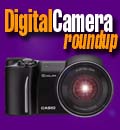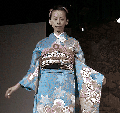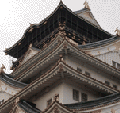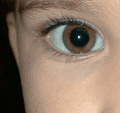|
Casio Exilim EX-Z77
Stylish 7.2-megapixel camera for the YouTube generation
(by Conrad H. Blickenstorfer)
For several years, Casio has been sort of the sleeper hit among digital cameras, with products that are consistently attractive, innovative and ahead of the curve. That is quite an accomplishment for a diverse company whose core business is in calculators and watches rather than photography. 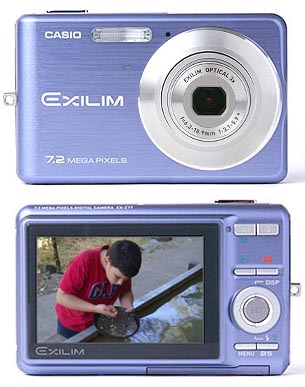 Recently, J.D. Power rated Casio's Exilim Zoom line as the 2007 winner in the Ultra Slim class - quite an honor and achievement. How does Casio do it? With a rapid succession of cameras that push the envelope.
Recently, J.D. Power rated Casio's Exilim Zoom line as the 2007 winner in the Ultra Slim class - quite an honor and achievement. How does Casio do it? With a rapid succession of cameras that push the envelope.
The Exilim EX-Z77, for example, boasts a special YouTube video mode in recognition not only of the popularity of the Google-owned video sharing service, but also its quest to appeal to the YouTube generation and, just in general, offer more.
What is the EX-Z77 and where does it fit in? First, there is a matter of definitions. The EX-Z77 is a member of Casio's "Zoom" line even though J.D. Power awarded it the "Ultra Slim" title. In Casio's lineup, the "Card" cameras are ultra slim while the "Zoom" line usually is a little thicker and has additional features. "Thicker" is relative as the Z77 is still just 0.78 inches thick, with a footprint of 3.74 x 2.32 - just a bit larger than a credit card. The camera weighs just about five ounces, battery and storage card included.
What you get
The Exilim EX-Z77 is a 7.2 megapixel camera with a 3X optical zoom, a 2.6-inch wide-format LCD display, digital image stabilization, and a variety of new features and technologies. Chief among them are face recognition for when you take portraits and group shots, and the ability to record MPEG-4 H.264 video, which also so happens to be the format YouTube is switching to (YouTube videos used to be Flash).
MPEG-4 H.264 Video
H.264 is a video compression standard that compresses MPEG-4 video more without any perceptible image degradation to the eye. This means you can record longer videos while you still essentially get MPEG-4 video quality. You get 640 x 480 pixel video at a full 30 frames per second and the technology is designed to reduce annoying "white speck" noise. It is a format especially suited for video-sharing websites like YouTube.com. In fact, while YouTube initially ran all videos in Flash, it is switching to H.264 video, thus being inherently more compatible with the file format this Casio produces. Vidoe files recorded in H.264 have the .MOV extension instead of the old (and much larger) .AVI files.
Face recognition
Face detection/recognition seems to be the must-have new feature of 2007. Most manufacturers have introduced new cameras with face recognition and use it as one of the major selling points. The technology is meant to adress the problem of getting portrait pictures where everything is sharp except the face of a subject, or group shots where the faces of the subjects are blurry or under/overexposed. The idea is to give the camera the ability to recognize human faces in a picture and set exposure for them. That is not an easy task with a single face. It becomes even more difficult with multiple faces, or keeping track of moving faces, as can happen in groups.
Casio usually tries to offer more, and that applies to its approach to face recognition as well. The Z77 not only claims to recognize a face or faces and automatically adjust for sharpness, shadow and light -- it also does auto-trimming, auto tracking, and it learns faces! While optimizing exposure for a face is standard, auto-trimming and zooming are not. Neither is auto-tracking that combines continuous focus with face tracking (for when a child is running around, for example), and definitely not face memory where the camera attemtps to learn and store individual faces.
The Z77 treats face recognition not as a "scene" mode but as a rather elaborate setting. You select to set it to Off, Normal, Family First, Priority, Record Family and Edit Family. It can get a bit confusing here, with the first three being modes and the second three settings. Under Priority you can select "speed" or "quantity." Record Family brings up a frame with a stylized face so you can record familiar faces by aligning the face template and then taking the picture. You can then store it and even assign a label to it, like "child," "mom," "frined," work," and so on. Edit Family lets you manage familiar face files. Once you have faces in your family file, setting face recognition to "Family First" will make the camera try to seek out familiar faces and concentrate on them.
Over 40 shooting modes
Picking a shooting or "scene" mode means you're setting the camera so that it takes optimal pictures in certain situations. Picking a scene mode is somewhere inbetween leaving everything up to the camera in its automatic mode, and doing everything yourself in full manual mode, which most point & shooters don't have. A scene mode takes full advantage of the increasing power of even inexpensive digital cameras by picking just the right combination of settings, something "auto" does not always do.
The Exilim Z77 has over 40 such scene modes, and really more if you add face recognition and anti-shake, which other cameras usually count as "scenes." Apart from the common portrait, landscape, night, food, fireworks, sunset and so on, you also get special modes to shoot business cards, whiteboards, optimized eBay pictures, getting multiple size ID photos on one shot, combining two or three snapshots into a single picture, an underwater mode that, of course, requires an underwater case, voice recording for as long as you want (or, rather, run out of space on the storage card), and Casio's innovative "short movie" and "past movie" that make sure you never again miss a crucial moment by continually rcording, but committing to storage only once you hit the shutter. This way you can actually capture the several seconds leading up to when you hit the shutter. That can be priceless! You can also toggle between an overview of the scenes and a more detailed view that includes a brief description.
One drawback of having all those scenes is that you have to wade through quite a view to get the one you want. And unlike, for example, Fuji with its "green button" that toggles between a chosen mode and fully automatic, with the Casio you have to remember to switch back from some esoteric mode to plain vanilla automatic if that is what you want and need. There is now, however, an "Easy Mode" that uses a four-leaf clover as its icon. Set the camera to that and it stays there. In Easy Mode you have no access to any scenes or anything. It is truly a fully automatic mode.
Design, controls and layout
Casio's designers have always been clear thinkers, both in hardware and software. Like all other Casio cameras, the Z77 has a crisp, clean look. Shutter and on/off button are on top. The backside has the large LCD display, a round 4-way navigation ring with a large "set" button in the center, a zoom rocker on top, red and green record and playback button, and the "Menu" and "Best Shot" buttons on the bottom. 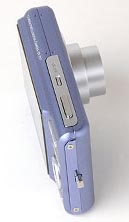 Actually, it's labeled "BS," a somewhat awkward acronym and another reminder that Casio has a bit of a tendency to let slip through less-than-perfect translations and localizations. Guys, it'd be so easy to clean that up. Actually, it's labeled "BS," a somewhat awkward acronym and another reminder that Casio has a bit of a tendency to let slip through less-than-perfect translations and localizations. Guys, it'd be so easy to clean that up.
Casio also makes excellent use of the wide screen by offering a menu bar along the right side. This way you have nine of the most common settings instantly available, without having to sift through menus.
One area where the EX-Z77 falls down a bit is the LCD, and that surprises us. Casios have always been at the forefront in terms of screen size, aspect ratio, and resolution. The display of the Z77 looks very large, but that's mostly because there is a black glass bezel around the screen which, with a diagonal size of 2.6 inches, isn't all that big, especially for a wide screen. Worse, its resolution of 115k falls short of what we've come to expect from premium brand digital cameras that now generally offer in the neighborhood of 230k pixel resolution. The display may have 479 x 240 pixels, but it seems like less. We hate to see Casio fall behind the state-of-the-art in LCD camera displays it dominated for so long.
Another area that disappoints is the pedestrian overall design. Maybe we got spoiled by the peerless look and feel of the Casio S500 and S600, those sexy slender jewels that felt like they were crafted from a single block (or sliver) of precious metal. The matte-silver Z77, in contrast, looks generic and and feels, dare we say it, a little chintzy. That quality feel is just not there the way're used to from Casio. It is a very well designed camera and it works very well, but it feels more like some nameless Chinese product than a Casio. This is especially unfortunate since the Z77 has so much more to offer than those generic designs.
Performance, on the other hand, is exemplary. This is a speedy camera and you hardly ever wait. It feels faster than older designs, and the three continuous shooting modes are all improved in speed. Picture quality, likewise, seems improved, and it's evident that Casio is forever tinkering to get any remaining rough edges out of the way.
Playback
Casio's ever-present resolve to offer more is also evident in Playback mode. It does all the usual stuff -- slide shows, data overlay, view 12 pics at once, zooming and panning, but also things you can't do in many other cameras. Movie playback uses VCR-style controls, and you can edit the length of clips easily. In-camera editing also goes beyond what most others offer. It's not just color correction here, but also cropping, dubbing, white balance and dynamic range adjustment, and it even lets you correct the shape of rectangular objects.
Included software
PhotoLoader with HotAlbum is an application that lets you import and pictures, create edited slideshows and then burn data or shows onto CDs. It's a Japanese concept with the idea of also using a HotAlbum compatible site, somethingw which seems more conducive if you live in Japan. Even the English is funky, and it might be better for Casio to stick with something unobtrusive and reliable for companion software. I mean, honestly: who wants a piece of software that installs itself and then brings up a pop-up every time you log in that says: "is there photos remained in your PC for long time? Let's enjoy the HOT ALBUM and bring it down as procious memory" That simply does nothing for Casio. There is also PhotoTransport to load pictures from the camera and move PC screen capture to the camera.
Summary
The Exilim EX-Z77 is a nice 7.2 megapixel camera that continues Casio's tradition to offer amazing performance and lots of interesting and useful features in slender, elegant cameras. While the addition of face recognition and a YouTube mode are the official selling points of this new Casio, we see them more as marketing issues. The big step is in switching to H.264 MPEG-4 recording that requires less space while retaining visual quality. The YouTube mode is, of course, welcome, as was/is the special eBay scene mode. The camera doesn't feel as sleek and solid as some other Casios, and the screen is a bit low-res and no longer state-of-the-art. Then again, when it comes to features, the Casio has no peers. Things like innovative movie modes and voice recording are often simply absent in the competition. The EX-Z77 has them all and then some, and at an attractive price.
We like:
- Crisp, logical design, layout and menus
- H.264 movie recording for small size at good quality
- Advanced face detection modes
- Over 40 scene modes
- You can get it in four colors
- Superior movie modes, including past movie
- Speedy operation and good image quality
Not so much:
- Mediocre, low-res screen
- Lacks the sleek, precision feel of other Casios
- Poor English translations and very marginal companion software
|
